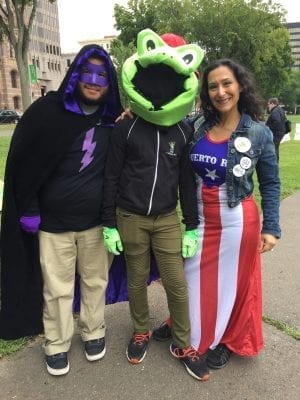 Living at UConn Storrs without a car can be challenging if you are a student that likes to adventure off campus. Even the simplest trips can be difficult. Living in an apartment, I have found that I often need to rely on friends to drive me to the grocery store. Luckily, a new alternative to having a car on campus just came to UConn! Zipcar, a car-sharing service, arrived on campus this fall.
Living at UConn Storrs without a car can be challenging if you are a student that likes to adventure off campus. Even the simplest trips can be difficult. Living in an apartment, I have found that I often need to rely on friends to drive me to the grocery store. Luckily, a new alternative to having a car on campus just came to UConn! Zipcar, a car-sharing service, arrived on campus this fall.
Zipcar allows students, faculty, staff, and community members to reserve cars on an hourly basis. There are currently 10 vehicles parked in several designated spots around campus. These locations include Northwest and Towers Residence Halls, Whitney Road, the Field House, and the Nathan Hale Inn. These cars are available 24/7, and after paying a $15 membership fee, can be reserved for as little as $7.50 per hour or $69 per day. After the first year, the annual membership fee increases to $25. The cost includes insurance, gas, and up to 180 miles of driving per day. Another attractive feature of this program is that unlike traditional car-rental, many of which have age limits between 21 and 24, the age limit for membership for this service is 18 for UConn students, faculty, and staff, and 21 for local community members.
This car-sharing service provides a new option for students who do not have cars or cannot afford to have a car on campus. The cheapest resident student parking permit costs $122 for the year and only allows you to park in C Lot, one of the farthest parking lots from the campus core. Additionally, Zipcar represents a more sustainable option for students wishing to travel. Car sharing is an alternative form of transportation that allows for fewer cars to be driven on campus. According to Zipcar’s website, each Zipcar covers the transportation needs of about 40 of their members, and surveys show that 1 in 4 members said they would have bought a car if they had not had the option of using Zipcar. This represents a significant number of cars not on the road. In this way, car sharing has the potential to reduce greenhouse gas emissions because fewer students may bring cars to campus in light of this option. Furthermore, this may reduce the need for parking spaces on campus, and Zipcar could act as a Low Impact Development, or LID, feature by reducing runoff. Thus, having this new car-sharing service at UConn will not only give students the option to be more independent, but also allow them to reduce their environmental impact.
Personally, I used Zipcar just this past week, and I found the process easy to navigate. After reserving a car using the Zipcar app on my cellphone, I was able to get the car at the parking lot in front of the UConn Field House, and drive from there. I unlocked the car using my Zipcard, which was sent to me in the mail. The actual car keys are left in the vehicle. The Zipcard is used to pay for gas, so that you do not have to pay for gas out of your own pocket. The car that I drove was clean and new, and my trip was smooth. When I had finished with my travels, I simply returned the car to the place where I had found it (a spot clearly marked where only Zipcars are allowed to park), left the keys in the car, and locked the car using my Zipcard. A few hours later, I received an email with trip details and the total cost.
I found my Zipcar experience to be very convenient, and I would recommend it to anyone who does not have a car and is looking to make a quick trip to the grocery trip, visit a friend, or go on an adventure. Along the way, you can feel good knowing your decision will help our community reduce its carbon footprint, and make UConn a more sustainable place to work and play!
Click here to join Zipcar!
-Jessica Griffin and Matthew McCann, Sustainability Interns


 Environmental justice, put simply, is the fair treatment and meaningful involvement of all people regardless of race, color, national origin, or income with respect to environmental conditions, regulation, and change. Those on the frontlines of climate change and other forms of environmental degradation are often the most economically and politically repressed. Impoverished island nations facing increased hurricane activity, poor urban communities facing the worst of air pollution, minority communities having little influence over the siting of a landfill in their backyard, and indigenous people facing potential contamination of their rivers by powerful oil companies should be given a seat at the table in discussions of policy and change. After all, they’re the ones who have experience dealing with the problems that we’re trying to solve.
Environmental justice, put simply, is the fair treatment and meaningful involvement of all people regardless of race, color, national origin, or income with respect to environmental conditions, regulation, and change. Those on the frontlines of climate change and other forms of environmental degradation are often the most economically and politically repressed. Impoverished island nations facing increased hurricane activity, poor urban communities facing the worst of air pollution, minority communities having little influence over the siting of a landfill in their backyard, and indigenous people facing potential contamination of their rivers by powerful oil companies should be given a seat at the table in discussions of policy and change. After all, they’re the ones who have experience dealing with the problems that we’re trying to solve. 



 Living at UConn Storrs without a car can be challenging if you are a student that likes to adventure off campus. Even the simplest trips can be difficult. Living in an apartment, I have found that I often need to rely on friends to drive me to the grocery store. Luckily, a new alternative to having a car on campus just came to UConn! Zipcar, a car-sharing service, arrived on campus this fall.
Living at UConn Storrs without a car can be challenging if you are a student that likes to adventure off campus. Even the simplest trips can be difficult. Living in an apartment, I have found that I often need to rely on friends to drive me to the grocery store. Luckily, a new alternative to having a car on campus just came to UConn! Zipcar, a car-sharing service, arrived on campus this fall.